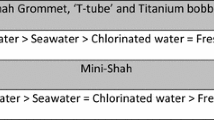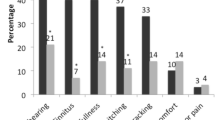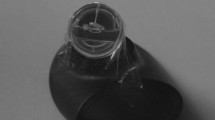Abstract
The insertion of grommets has been one of the most common procedures carried out by ENT surgeons for patients with persistent middle ear fluid. There has always been apprehension at the use of grommets by patients undertaking swimming or other water sports due to concerns of grommet penetration by water into the middle ear. Despite this, no common consensus exists amongst otolaryngologists regarding post-operative advice following grommet insertion. Most studies focus on surface swimming and do not consider other activities such as diving that patients may undertake. This study aimed to determine the hydrostatic head required for water to pass through a grommet using different water-based solutions. These were selected to simulate conditions such as swimming and showering or bathing. An improved model of a grommeted middle ear (based on previous work by Ricks et al.) was constructed using two 5-ml plastic syringes, latex (from a surgical glove), two rubber neoprene membranes and a Shah Ventilation Tube (1.14 mm). Different water solutions were added to the system and the hydrostatic head measured using digital calipers. The results revealed that the hydrostatic head required to penetrate a grommet is lowest using soapy water and highest with distilled water. The differences between chlorinated water and 3% saline were not significant. We hope that this study can be used in conjunction with previous work to better prepare the ENT surgeon in giving suitable post-operative advice following grommet insertion.



Similar content being viewed by others
References
Armstrong BW (1954) A new treatment for chronic secretory otitis media. AMA Arch Otolaryngol 59(6):653–654
Rosenfeld RM, Schwartz SR, Pynnonen MA, Tunkel DE, Hussey HM, Fichera JS et al (2013) Clinical practice guideline: tympanostomy tubes in children. Otolaryngol Head Neck Surg 149(1 Suppl):S1–S35
Basu S, Georgalas C, Sen P, Bhattacharyya AK (2007) Water precautions and ear surgery: evidence and practice in the UK. J Laryngol Otol 121(1):9–14
Carbonell R, Ruiz-Garcia V (2002) Ventilation tubes after surgery for otitis media with effusion or acute otitis media and swimming. Systematic review and meta-analysis. Int J Pediatr Otorhinolaryngol 66(3):281–289
Moualed D, Masterson L, Kumar S, Donnelly N (2016) Water precautions for prevention of infection in children with ventilation tubes (grommets). Cochrane Database Syst Rev 27(1):CD010375
Marks NJ, Mills RP (1983) Swimming and grommets. J R Soc Med 76(1):23–26
Pashley NR, Scholl PD (1984) Tympanostomy tubes and liquids—an in vitro study. J Otolaryngol 13(5):296–298
Ricks RG, Easto R, Reddy VM (2016) The water penetration of different ventilation tubes. Eur Arch Otorhinolaryngol 273(10):3131–3134
Hebert RL 2nd, Vick ML, King GE, Bent JP 3rd (2000) Tympanostomy tubes and otic suspensions: do they reach the middle ear space? Otolaryngol Head Neck Surg 122(3):330–333
Smith LP, Smullen JL, Younis RT (2005) Differential penetration of ototopicals and water through tympanostomy tubes. Laryngoscope 115(8):1367–1370
Hebert RL, King GE, Bent JP (1998) Tympanostomy tubes and water exposure: a practical model. Arch Otolaryngol Head Neck Surg 124(10):118–121
Author information
Authors and Affiliations
Corresponding author
Ethics declarations
Conflict of interest
Yousef Ibrahim declares that he has no conflict of interest. Paul Fram declares that he has no conflict of interest. Gavin Hughes declares that he has no conflict of interest. Pete Phillips declares that he has no conflict of interest. David Owens declares that he has no conflict of interest.
Research involving human participants and/or animals
This article does not contain any studies with human participants or animals performed by any of the authors.
Informed consent
Not applicable.
Funding
None.
Rights and permissions
About this article
Cite this article
Ibrahim, Y., Fram, P., Hughes, G. et al. Water penetration of grommets: an in vitro study. Eur Arch Otorhinolaryngol 274, 3613–3617 (2017). https://doi.org/10.1007/s00405-017-4700-y
Received:
Accepted:
Published:
Issue Date:
DOI: https://doi.org/10.1007/s00405-017-4700-y




